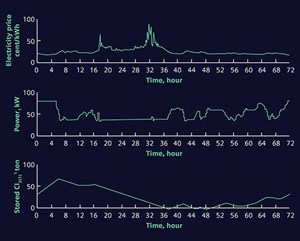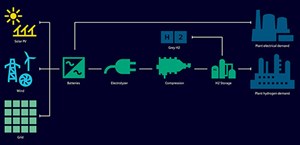Articles
Utilize digital technology to accelerate industrial decarbonization
Special Focus: Digital Technologies
B. DE GROOT, Siemens gPROMS, London, United Kingdom
Combating climate change is a major challenge for chemical engineers. Driven by a combination of tightening government regulations and incentives [such as the U.S. Inflation Reduction Act (IRA) and the EU’s Emissions Trading Scheme], recent pressure from customers, employees and society has increased industry’s awareness and acceptance regarding the role it must play to address this challenge. The chemical industry is a large part of the problem [close to 30% of global greenhouse gas (GHG) emissions originate from industrial activity].1 Concurrently, the industry has the potential to provide a major part of the solution by decarbonizing its operations and providing technology for other industries to decarbonize.
As a result, process organizations globally are adopting net-zero goals and formulating strategies. Many are now factoring the cost of predicted carbon emissions into investment decisions, thereby providing a mechanism that favors the implementation of low- or zero-carbon technologies over their high-carbon incumbents. These industrial decarbonization efforts are a major driver for innovation. However, it is becoming clear at recent Conference of the Parties (COP) events that plans for industrial decarbonization announced to date will be insufficient to limit global warming to the desired 1.5°C.
We must use all available technology to accelerate the transition to net-zero to support increasingly ambitious plans. This article details how recent developments in digital technology help progress and accelerate industrial decarbonization, ranging from harvesting low-hanging fruit to promoting fundamental changes in production processes.
Tier 1 measures: Reduce carbon intensity of existing processes. Achievable in the short term with no significant capital expenditure (CAPEX) required:
- Efficiency improvements can be achieved by implementing energy management systems (EMSs): EMSs are based on real process knowledge and make suggestions to operators on actionable measures to reduce emissions and costs for integrated industrial activities such as chemical sites or refineries, with proven savings of 3%–5%, providing return on investment (ROI) in months.
- Demand-side management and response: As the share of renewables in the energy mix grows, grid operators face a temporal and geographical mismatch in supply and demand that requires CAPEX to overcome. As a more attractive alternative, financial incentives are available to large-point users willing to introduce flexibility in their operations depending on the prevailing energy costs. Digital tools play an important role in minimizing costs without adversely affecting process safety, product quality and equipment lifetime. Recent studies have shown that by making use of short-term (72-hr) forecasts for energy prices, large users can save up to 8% on their energy bill by intelligent use of process flexibility while reducing peak load by 28% (FIG. 1).2
- Product carbon footprint (PCF) management: Suppliers face pressure from their customers to provide information on the amount of GHG emitted from product production. Since most emissions are in Scope 3 (originating outside the company gates), generating PCF information requires collaboration across the supply chain. Standards such as those published by Together for Sustainability aim to provide a level playing field for PCF reporting.3 Digital technologies based on blockchain help companies share verifiable, secure and up-to-date information on PCF.

Tier 2 measures: Reduce the carbon intensity of existing processes with proven complementary technology. Achievable in the medium term with some CAPEX required, though not requiring fundamental changes to the production process:
- Application of carbon capture, utilization and storage (CCUS): Carbon dioxide (CO2) removal technologies have been used for decades in gas processing facilities and are experiencing a revival in other sectors, including chemicals, energy, steel and cement. In most geographies, the route to large-scale implementation is via establishing CCUS hubs—industrial areas where large emitters are co-located and have a shared interest in establishing CO2 transportation and storage facilities. CAPEX and operational expenditure (OPEX) remain key considerations, and digital tools are helping to select those technologies and optimize designs to minimize cost by reducing the energy penalty from the capture and compression assets, designing control systems to deal with process disturbance, startup and shutdown, minimizing solvent degradation and providing real-time advice to injection system operators.
- Production and utilization of green hydrogen (H2): Aside from being widely promoted as an energy carrier, H2 is already produced at scale from natural gas for use in refineries, but several refineries globally are investing in the onsite production of green H2 (i.e., from renewable sources). Given the intermittent nature of renewables and a preference among offtakers and electrolyzer systems for continuous production, a key question is how best to size storage facilities for electrical energy and H2. Once they have played their role in design, the purpose of digital tools shifts to a H2 energy management system (HEMS), advising operators on how to minimize H2 production costs through intelligent management of the available production and storage facilities, and making use of short-term predictions in energy supply and H2 demand (FIG. 2).

Tier 3 measures: Sustainable process technology development. These measures will only partially get us to net-zero, necessitating more fundamental changes to production processes. Startups are exposed to significant risk, and digital technologies are used to accelerate innovation, reduce time to market and manage risk for emerging technologies. Some examples include bio-based feedstocks, CO2 utilization to produce synthetic fuels and pyrolysis of waste materials.
Digital technologies play an important role in developing sustainable process technologies by reducing the costs of lab and pilot programs, enhancing research and development (R&D) effectiveness and supporting investment decisions. Once a validated process digital twin is in place, it can support decisions for design scale-up to provide confidence to investors and next-generation process development.H2T
LITERATURE CITED
1 Ritchie, H., P. Rosado and M. Roser, “Emissions by sector,” Our World in Data, June 2020, online: https://ourworldindata.org/emissions-by-sector
2 Otashu, J.I. and M. Baldea, “Demand response-oriented dynamic modeling and operational optimization of membrane-based chlor-alkali plants,” Computers & Chemical Engineering, November 2018, online: https://www.researchgate.net/publication/328709337_Demand_response-oriented_dynamic_modeling_and_operational_optimization_of_membrane-based_chlor-alkali_plants
3 “Scope 3 GHG emissions programme,” Together for Sustainability, online: https://www.tfs-initiative.com/how-we-do-it/scope-3-ghg-emissions

